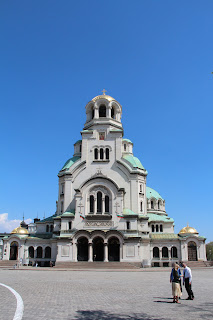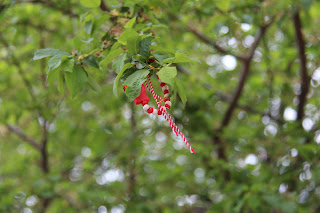A few months ago, my bulgarian
colleague asked me if I'd be interested in leading a workshop in a
professional development event they'd hold in April in Sofia. Of
course I was interested, but back then I didn't think much about
going to Sofia. When the event approached, I bought a guidebook, and
interestingly enough I didn't find one on Sofia, but only on
Bulgaria, and there was not much information on the capital city in
there. I was disappointed, started researching online and started to
look very much forward to going there when I read about the
architechture and the rich history of Sofia.
 The flight was amazing, blue sky and a fantastic view of the alps - see the background image of the blog.
The flight was amazing, blue sky and a fantastic view of the alps - see the background image of the blog.My bulgarian colleague had warned us that the weather might already be quite warm in April, and indeed: from about 10°C in Zurich to about 30°C in Sofia! This caused enough heat-induced confusion in my head to forget my beloved jacket in the taxi that brought us to the hotel. And because I didn't need the jacket in the following days (we walked around in T-Shirts) I only noticed it was missing while packing for the return trip. Oh well. It was my favourite jacket, bought in Berlin two years ago. Not my best memory of Sofia, but all my fault.
On the very first evening, my bulgarian colleague and his girlfriend took our german colleague and me to lake Pancharevo outside Sofia. The lake is a very special place, though slightly creepy - have a look. We had dinner in a restaurant right at the lake and really enjoyed the sunset before returning to the city.
Nonetheless, pure luxury, as were the expensive shops in this central part of the city. But when you walk a while and turn into one of the narrow alleys - all of a sudden you find yourself in a different city, with people begging in the streets and lots of garbage in the yards and on the pavements.
Discussing with the bulgarian colleagues, I learnt that young, well educated bulgarians often leave their country because they don't see much of a future for themselves there. But on the other hand, at least in Sofia, you can find many innovative ideas and business models, for example cafès and special shops like Zona Urbana (where I spent a lot of my leva!). They sell amazing things made from recycling material, for example from sheet music, maps or newspapers, milk cartons and similar things: very nice iPad sleeves (I could have sold mine several times to friends!), wallets, lamps, bags, stuffed animals and other toys as well as really cool bracelets and earrings. I could have spent hours in their shop, looking at their products and chatting to them about where they've got the material - even newspapers from the Thirties, from Switzerland!
Well, the contradictions are nothing I wouldn't know from other big cities, but it all seems to be a bit more extreme in Sofia. And it was my very first time in a place where I couldn't read all the street signs, as they are mostly in Cyrillic script and only in the very centre of the city also in latin letters, so I got lost several times. Asking someone for the way is not that easy, most people are very friendly but don't speak English. This makes even buying stamps for my postcards a little adventure.
But Sofia is beautiful. Alexander Nevsky cathedral is a fantastic sight from the plane when closing in on Sofia, it's a huge church, impressively decorated both in- and outside.
 |
| Alexander Nevsky Cathedral |
 |
| Market in front of Alexander Nevsky cathedral |
 |
| The russian orthodox church |
 |
| Ivan Vazov National Theatre |
 |
| Sedmochislenitsi Church |
 | |||
| Banya Bashi Mosque |
On our last evening in Sofia, we went to a traditional bulgarian restaurant for dinner, a very nice experience. I didn't take pictures of the food (it was great!) but of the dancers! I love taking pictures of people doing what they really like to do.
When you walk through Sofias's parks in springtime, you will see red-white strings and tassels knotted to the branches of the blossoming trees. We wondered what this might mean and finally asked our city tour guide - and he actually gave such a red-white bracelet to everyone of us, explaining that it's a bulgarian tradition. People give the Martenitsa to friends and family, wishing good health, on the first of March, they wear it around their wrists or pinned to their clothes until they see the first stork. Then they tie it to a blossoming tree for luck. I like this tradition a lot and still wear my Martenitsa, I had already seen a stork in Switzerland before I travelled to Bulgaria in the end of April. This is one of the nicest memories of Sofia - the red-white bracelets all over the trees.

















No comments:
Post a Comment